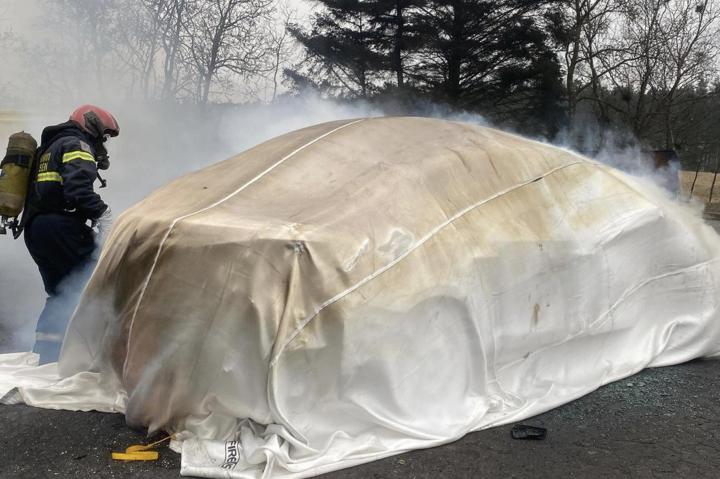News
How EV fire blankets could help contain Electric Vehicle fires
Although it's not gonna save the EV that caught fire, it looks capable of preventing the fire from spreading to adjacent cars or surrounding objects.
BHPian sarathlal recently shared this with other enthusiasts.
We all know by now that EV fires are an extremely dangerous breed, mainly due to their thermal runaway. Once started, it is extremely difficult and extremely resource-consuming to contain one.
Companies are now betting on an old-age technique of using Fire Blankets to contain EV fire. They work on the principle that for a fire to burn, all three elements of the fire triangle must be present: heat, fuel and oxygen. The fire blanket is used to cut off the oxygen supply to the fire, thereby putting it out.
A fire blanket is so large that a burning vehicle can be completely covered with it and is extremely heat-resistant.
Although it's not gonna save the EV that caught fire, this looks capable of preventing the fire from spreading to adjacent vehicles or surrounding objects - like apartment building parking, closed parking lots etc.
An example video demonstrating the working.
Here's what BHPian NomadSK had to say about the matter:
That's correct, such fire blankets are used to smother the fire. They are mostly made up of Glass fabric and flame retardant material hexafluorozirconate and zirconium acetate, sometimes covered with a layer of calcium silicate.
However, the video depicts it to be very easy to use. Conceptually it is fine. But in reality, such blankets are super heavy to be handled by one or two people for the car to be covered with it. Generally, this is the inventory with the firefighters and we use such blankets to cordon off the area while welding (Hot work) is in progress in a classified/restricted area.
This is the smaller version of the fire blanket being used in our kitchen. And heck even our office clothing is flame-resistant.
Here's what BHPian Jeroen had to say about the matter:
Sure enough, it can be used to initially contain a fire, if you can get close enough to put it on.
But in case of a runaway battery fire, it won’t be sufficient. The blanket doesn’t cool, it just smoulders. So the fire would still rage on and flare up as soon as you remove the blanket.
Whereas a fire on a regular petrol/diesel car will take 5 minutes and a couple of hundred liters of water to put out, an EV can take up to 5 hours and tens of thousands of gallons of water.
Some fire departments have what is essentially a large portable tank. They simply dunk the Burning EV into it and leave it underwater for a day or so.
Here's what BHPian Shreyans_Jain had to say about the matter:
Won’t work. Lithium battery gives off its own oxygen when it undergoes combustion. Doesn’t need outside air for thermal runaway. So, the idea of breaking the fire triangle by depriving it of oxygen goes out of the window right there. Also, lithium fires burn much much hotter than conventional fuel fires. The ‘blanket’ needs to be tough enough to withstand that.
Here's what BHPian De-Veer had to say about the matter:
These don't smother out the fire, or cut off the oxygen supply. They are extremely tight-knit kevlar-based compounds basically, and work on containment of the fire. This is essential for places like electric chargers where 1 car on fire can ignite the nearby ones as well, not too dissimilar to a normal vehicle fire. I enquired about these for my factory last year. The cost is atrocious $3500, but feasible for fire departments etc.
Lithium fires burn hotter but they are nuanced in a way that these are not constant fires like fuel. Total sustained heat load is similar, but the time taken for the burn is larger. So the average distributed heat load is lesser than fuel.
Eg. If the specific energy of 1 full tank of petrol can take you 500km, and 1 Full EV can take you 500km. If both these catch fire, the petrol vehicle will burn down in 2-4 hours, and EV fire will continue to burn in a domino effect for the next 24-36 hours. You can contain the EV fire because there's no "explosive effect" as such.
This is a VERY GOOD technology, till last July there was only 1 commercially available company with the patent, there are copycats coming up everywhere. The cost should come down, but not by a lot. Also, this cannot be installed in the battery, as there are already better measures implemented to prevent fires in a battery pack. These are rare events.
Check out BHPian comments for more insights and information.




















